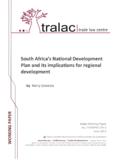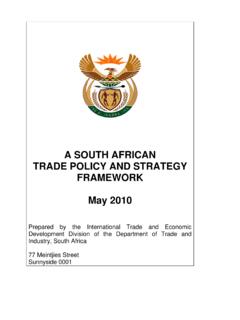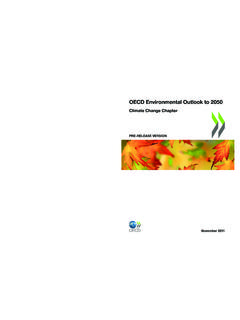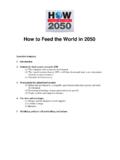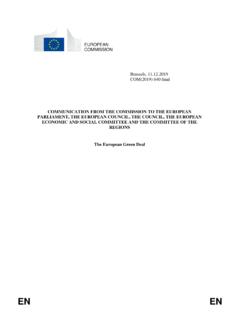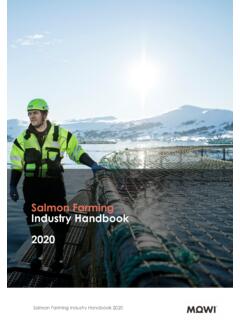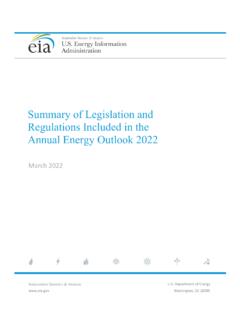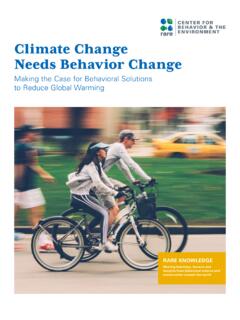Transcription of AGRICULTURE IN AFRICA - tralac
1 AGRICULTURE IN. AFRICA .. Transformation and outlook Feeding AFRICA and the World Our continent has enormous potential, not only to feed itself and chains, improving national and regional agricultural markets, fos- eliminate hunger and food insecurity, but also to be a major play- tering AFRICA 's collective food security and improving the manage- er in global food markets. This potential lies in its land, water and ment of natural resources. oceans, in its men and women, in its knowledge and huge mar- Over the last decade, where countries have increased invest- kets. Recognizing this opportunity, the African Union chose 10 ments in AGRICULTURE as per CAADP targets (or have exceeded), years ago to make AGRICULTURE one of the pillars of the New Part- they have seen reductions in hunger and poverty, and increas- nership for African Development. es in productivity. This includes countries such as Ghana, Togo, AGRICULTURE forms a significant portion of the economies of all Zambia, Burundi, Burkina Faso, Mali, Niger, Congo, Senegal, African countries, as a sector it can therefore contribute towards Ethiopia and Malawi.
2 In an effort to boost investments and pro- major continental priorities, such as eradicating poverty and hun- ductivity, intra-African trade and regional agrifood value chains, ger, boosting intra- AFRICA trade and investments, rapid industri- ECOWAS, SADC, ECCAS and EAC have put in place regional ag- alization and economic diversification, sustainable resource and ricultural policies. environmental management, and creating jobs, human security 2014 will be the Year of AGRICULTURE in AFRICA . We will use this and shared prosperity. as an opportunity to accelerate our drive for food security, to We have come a long way since 2003. We committed to a pro- become a net exporter of food, to add value to our agricultural cess across the continent that mobilizes all member states, stake- products and for regional integration. Our engagements during holders in the agrifood sector, and primarily, agricultural produc- this year in global trade negotiations, including on the Economic ers' organizations, regional institutions and technical institutions.
3 Partnership Agreements with the European Union, will therefore This process recognizes that African women constitutes close to continue to focus on these African priorities. seventy percent of the agricultural workforce and are major con- This document provides us with a clear diagnosis of the oppor- tributors to food production and security. Mainstreaming their tunities and challenges we face, and presents our vision and pri- participation and empowerment in AFRICA 's agricultural revolution orities. As we move towards finalizing our continental vision for is therefore critical. AGRICULTURE and agribusinesses can also pro- the next fifty years Agenda 2063 it is an important guide on vide opportunities to millions of our young people entering Afri- this critical African sector. ca's labour markets every year. AFRICA will have a population of two billion people by 2050, the The Comprehensive African Agricultural Development Pro- majority women and youth.
4 This prediction alone summarise the gramme (CAADP) seeks to drive our continental agricultural rev- scale of our agricultural challenges: to feed Africans and to cre- olution, by increasing investment in AGRICULTURE , fostering entre- ate wealth for them, and to conserve resources for future gen- preneurship and investment in agribusinesses and agrifood value erations. Dr. Nkosazana Dlamini Zuma, Chairperson of the African Union Commission AGRICULTURE IN AFRICA 3. 4. FOREWORD. AGRICULTURE as a driver of economic transformation in AFRICA The Comprehensive AFRICA AGRICULTURE Development Programme tor should benefit. Finally, farmers are the primary guardians of (CAADP) is now in its tenth year. It has brought the importance our natural heritage and environmental assets, and they should of AGRICULTURE to the continent's economic transformation back be granted opportunities to preserve and build on those assets. to the forefront. It also attests to a new approach to the way in The history of our continent is punctuated with greed for our which AFRICA is shaping its future, with development and invest- soil and subsoil.
5 This should encourage us to consider the op- ment choices made by Africans providing the framework for con- portunities provided by our diversified ecosystems, the relative- tributions from our partners and investment decisions. ly low population density of our land, rising global food demand This AU-NEPAD AGRICULTURE programme has provided many and the positive trends for new sources of development funding. benefits, one of which was that it strengthened democratic pro- Our role as decision-makers is to provide the impetus needed cesses by making the participation of all stakeholders, including to ensure that our farmers make their profession an economic farmers, a guiding principle. AGRICULTURE is everyone's business: activity that generates well-being in rural areas, and meets em- national independence depends on its development because it ployment challenges and the expectations of our citizens, name- enables us to escape the scourge of food insecurity that under- ly those relating to security, well-being and independence.
6 This mines our sovereignty and fosters sedition; it is a driver of growth is why we were inspired to publish this document, a white paper, whose leverage is now acknowledged by economists and poli- which, based on the fortunes and misfortunes of the agricultur- ticians; it is the sector offering the greatest potential for poverty al sector over several decades, traces the path of an agricultural and inequality reduction, as it provides sources of productivity project based on the momentum generated by the CAADP. from which the most disadvantaged people working in the sec- Ibrahim Assane Mayaki, Chief Executive Officer of the NEPAD. Agency AGRICULTURE IN AFRICA 5. Publication: NEPAD (New Partnership for African Development). Director of the publication: Ibrahim Assane Mayaki, Chief Executive Officer of NEPAD. Overall coordination: Estherine Lisinge Fotabong, Programme Director of NEPAD. Editor: Bureau Issala Authors: Roger Blein, Martin Bwalya, Sloans Chimatiro, Beno t Faivre-Dupaigre, Simon Kisira, Henri Leturque, Augustin Wambo-Yamdjeu Graphics and layout: E.
7 Jeudy Photo and documentary credits: NEPAD, UNEP, CIRAD, FAO. English translation: Verbastream LLC and Anna Kiff This paper on African AGRICULTURE was produced by the NEPAD. Agency for the African Union. It is based on the synthesis of nu- merous works, data, documents and reports from regional and in- ternational institutions and research and development organisa- tions (FAO, World Bank, UNDP, UNEP, AUC, UNCTAD, IMF, WTO, OECD, Land Matrix, ECA, ReSSAKS, CIRAD, NEPAD and AFRI- STAT). The authors would especially like to thank UNEP for providing maps of natural resources. Reference title: African AGRICULTURE , transformation and outlook. NEPAD, November 2013, 72 p. NEPAD. International Business Gateway New Road & 6th Road Midridge Office Park c/o Challenger & Columbia Avenue Block B. Midrand Johannesburg 1685, South AFRICA Tel: + 27 (0) 11 256 3600. Web site: Reproduction may be quoted or reprinted but full acknowl- edgement is requested 6. TABLE OF CONTENTS.
8 Executive summary page 8. African agricultural paths page 13. Policies, institutions and stakeholders page 37. Challenges and opportunities for African AGRICULTURE page 51. Guidelines and tools for action page 61. Acronyms page 75. AGRICULTURE IN AFRICA 7. Executive summary Our perspective on certain African agricultural development paths over the last 30 forests and classified areas. As a general trend, land is being de- years graded and natural capital eroded. concepts Contrary to popular belief, agricultural production in AFRICA has Farming systems mainly rely on family resources increased steadily: its value has almost tripled (+160%), and is al- The adoption of innovation required to in- most identical to that of South America, and below but compa- More so than in other continents, AFRICA is dominated by family crease productivity cannot be simply decreed. rable to growth in Asia. However, there has been very little im- farming, which relies mainly on family labour.
9 AFRICA has 33 mil- Innovations must meet the needs of producers provement in production factors (labour and land). Agricultural lion farms of less than 2 hectares, accounting for 80% of all farms. and, for health and environment, must concern growth in AFRICA is generally achieved by cultivating more land While the agricultural labour force is comprised mostly of wom- the entire national communities. More important- and by mobilising a larger agricultural labour force, which produc- en, rules governing ownership and transfer of land rights are less ly, innovation implies risks that farmers would es very little improvement in yields. On average, cereal yields are favourable to women than in Asia and Latin America. consider as minimal in a more predictable en- less than half those obtained in Asia. Over the last 10 years, large-scale investment contracts in Afri- vironment with more secure predicted incomes This agricultural growth occurred in an unprecedented de- ca have covered 20 million hectares, which represents more than that justify the adoption of new technology pack- mographic context.
10 In the last 30 years, AFRICA 's population has the arable area of South AFRICA and Zimbabwe combined. Indeed, ages. Such an environment entails securing land doubled overall and tripled in urban areas. The most direct con- AFRICA 's natural potential is under threat. Many farming systems access and tenure, more stable and predictable sequence of this exponential population growth is that the con- are struggling to replenish soil fertility due to the lack of invest- prices, and insurance and safety nets for farm- tinent now has more mouths to feed. Yet cereal production has ment capacity and secure land tenure. Won over by the idea of in- ers, among others. Contrary to the current wide- been unable to keep pace with population growth, since it has dustrial farming, decision-makers are sometimes inclined to make spread reluctance of our cooperating partners only increased by a factor of This gap is even wider for pro- it easy for overseas groups to acquire land, not always with the to encourage subsidy schemes in African agri- cessed products and meat, which are increasingly called for by greatest transparency.

